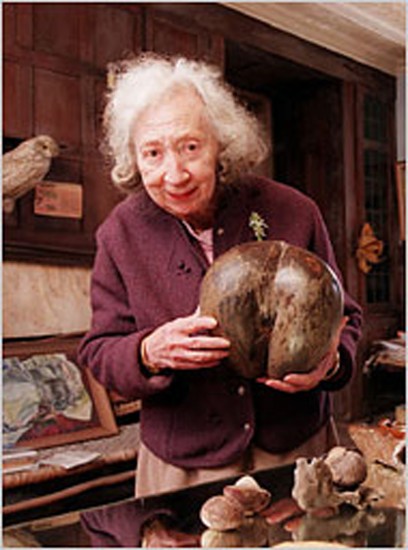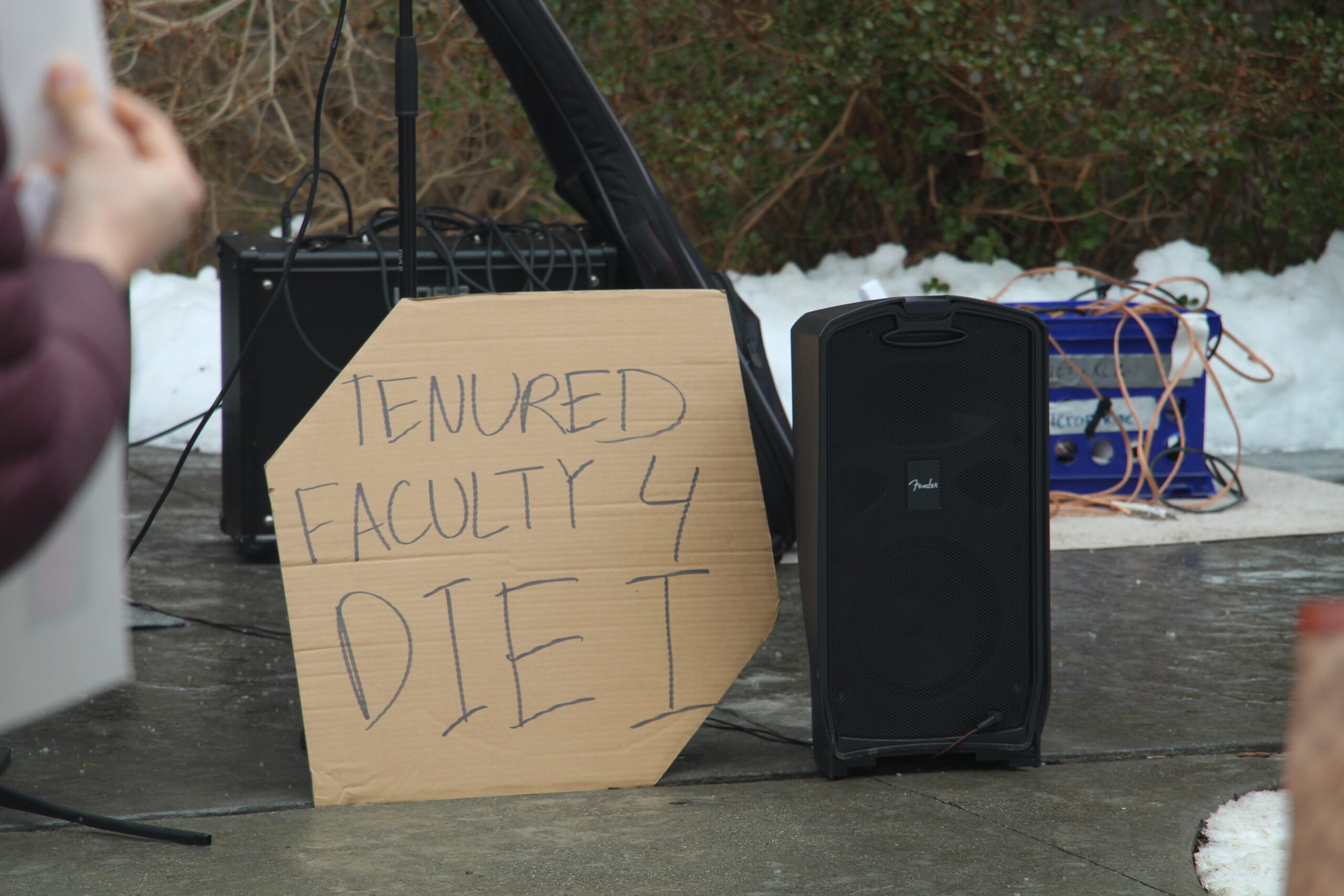
Elizabeth Tashjian, American painter, 1912-2007, shows off one of her nuts.
For years Christopher Steiner, art history professor and director of the Museum Studies Program at Conn, sent his students to visit The Nut Museum of Old Lyme, but he himself had never been. He had never met The Nut Lady, paid the $3 and one nut entrance fee to the museum, or seen the infamous thirty-five-pound coco-de-mer nut which shares a disturbing resemblance to a woman’s behind. Yet for some reason, when the contents of the Museum were in danger, Professor Steiner negotiated with the town of Old Lyme to donate all of the museum’s contents to Connecticut College. He and his students spent the next three years cataloguing the contents of the museum and showing the work in several exhibitions. So why, after never visiting the museum, did Professor Steiner save a stranger’s life work? What was this woman’s fascination with nuts? Or more importantly, who was The Nut Lady?
As students in the Museum Studies Program will agree, a trip to The Nut Museum was not the typical museum experience. There were no crowds of silent people milling about and whispering to one another in hushed tones, or no children getting antsy as their parents try to puzzle through the meaning of a Rothko. Rather, The Nut Museum was a different undertaking in and of itself, with Elizabeth Tashjian (a.k.a The Nut Lady) being an integral part of the experience, if not the highlight. After paying admission visitors would be given a personalized tour, led by Elizabeth, that covered the contents of the museum, her philosophy about nuts, and ended in a performance of her original anthem dedicated to nuts entitled, “Nuts Are Beautiful”. However bizarre, this tour offered visitor’s insight into the creation of the nut museum.
Ms. Tashjian had always been fascinated with nuts and as a young adult attended the National Academy of Design, a prestigious art school, in the 1930’s. While a student there she began painting a variety of still lifes all comprised of nuts and eventually began to paint magnifications of nuts as well. After graduating, she and her mother moved to a gothic mansion in Old Lyme, CT where they lived together until the 1950’s when her mother died. Seeking a way to make money and follow her passion for nuts Elizabeth decided to open The Nut Museum and was henceforth known to most as The Nut Lady.

Tashjian stands next to a large paneled painting of hands holding a nut and a nutcracker. Photo courtesy of Smithsonian Commons.
But Tashjian had a larger goal in mind than to simply hoard a variety of nuts and nut-inspired chotchskies. She was actually a devoted Christian Scientist who believed that her passion for nuts served a greater purpose. Contrary to what you may think, the double entendre associated with the word “nut” was not lost on The Nut Lady herself. She was no fool, although she did not believe in evolution and expressed a belief that perhaps we originated from nuts. Rather, she embraced the idea of being associated with both the edible morsel and the slang term for insane. She believed that society did a terrible wrong by marginalizing individuals who were unusual, unique or nutty. She saw her collection of nuts as a way to help those cast aside by society. Hopefully, by elevating and promoting the nut, she could reach out to millions.
Tashjian continued this mission for many years until, one day in 2002, she lapsed into a coma. Doctors believed that she did not stand a good chance of recovery since she was nearly ninety and, as a Christian Scientist, eschewed modern medicine. To make matters worse, while in her coma, the state looked into her finances and found she owed so many back taxes that they put her house, and its contents, on the market to pay off her debt. Luckily, a real estate agent and friend of Steiner’s alerted the professor and asked if he was interested in checking out the museum before it was auctioned off. Seeing this as his last opportunity to experience the museum, Steiner visited the gothic mansion and decided to negotiate with the town of Old Lyme to donate the museum to Conn. Two weeks later, by a medical miracle, The Nut Lady awoke from her coma outraged at the loss of her home but grateful that Conn and Steiner had saved her life’s work.
Although she was moved to a nursing home in Old Saybrook, Tashjian spent the next few years working with museum studies students to go through the contents of the museum. Rather ironically though, most of the items from the museum were not actual nuts, as she only had around twenty of them. Instead, the students sorted through over one hundred paintings, twenty aluminum sculptures, and countless boxes filled with letters, newspaper clippings, and photos about the museum and nuts. These students also helped to put on a small show in Shain Library in 2003, followed by a larger, better publicized show at the Lyman Allyn Art Museum the following year.
Despite her eccentric nature, Tashjian and the students greatly enjoyed working together. She found the students unjaded and endowed with exuberant creativity while they described her as intelligent and quick witted. She also was a supporter of Steiner’s, since he was the one who saved her museum; however, their relationship grew tense towards the end of her life. Steiner explained, “Elizabeth was always looking for the next project, the next step for the nuts, but after Shain and the Lyman Allyn there wasn’t anything else” so she began to grow disheartened. Another strain on their relationship resulted when Steiner expressed his interest in writing a book about the nut museum. Tashjian was upset because the professors proposed book would not focus solely on the nut museum and, presumably, because she didn’t want any competition when she got around to writing a book about herself. Only now that she has passed on has Steiner resumed work on his book “Performing the Nut Museum: Elizabeth Tashjian and the Art of the Double Entendre”.
As for The Nut Lady, who died at age 94, she accomplished her dream of spreading her love for nuts. After the Old Lyme Nut Museum was well established, she became a frequent guest on many television and radio shows including those of Johnny Carson, David Letterman, Jay Leno, Howard Stern and Chevy Chase. When she died, on January 28 2007, she was even honored with a fairly lengthy obituary in The New York Times. The Nut Lady became an endearing figure to many. She embodied everything we love in an artist: passion, commitment and a little bit of spunk.










This piece turned out awesome, Julia. Way 2 go. Wish I knew her.
Julia
I will be visiting CT in May – is it possible to still visit the Nut Museum or the collection? Thanks – Katherine
Her museum is no longer open but currently there is an exhibit of her work that students have put together in the Cummings-the arts building on campus
We were fortunate to visit the Nut Museum with several members of the 2nd Co. Governor’s Horse Guard who were in an encampment at Camp O’Neil. Ms. Tashjian was quite entertaining describing the nuts in her collection, singing her original song about them (the nut masks she wore were a bit scary for the younger children in our group) and proudly displaying her paintings. Her passion really came through in her presentation. (Admittedly, the painting in which a fetus was in a walnut shell, was a a bit odd, but overall it was a most interesting experience and one that we speak of from time to time.) Thank you for being the custodian of the collection that meant so much to her.